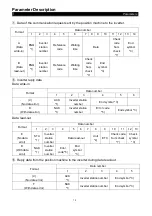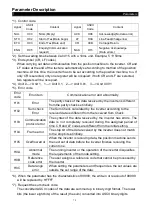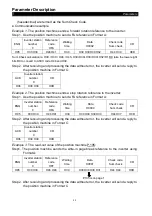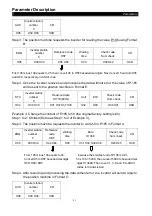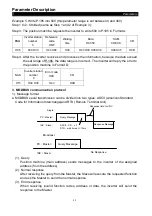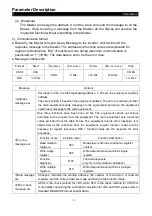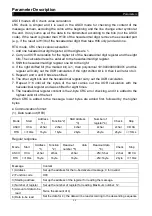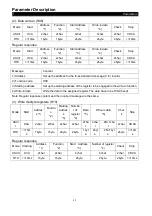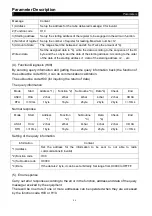
Parameter Description
Parameters
87
Mode
Starting
Address
*1)
Function*2)
H80+function
Error code
* 3)
Check
Stop
ASCII
H3A
2char
2char
2char
2char
0D 0A
RTU
>=10ms
1byte
1byte
1byte
2byte
>=10ms
Message
Content
1) Address
Set up the address for the to-be delivered message; 0 for invalid.
2) Function code
The function code set for the main equ H80
3) Error code
Set the codes listed in the table below.
The list of error codes:
Source
Code
Meaning
Remarks
Slave
reply
H01
Invalid function
code
Set up function codes that cannot be handled by the equipment
in the query message sent by the main equipment. Function
codes that are not H03, H06, H08 and H10 (temporarily).
H02
Invalid data
address
Set up addresses that cannot be handled by the equipment in
the query message sent by the main equipment (Asides from
the addresses listed in the address table of the register;
preserve the parameters, prohibit parameter reading, prohibit
parameter writing).
H03
Invalid data value
Set up data that cannot be handled by the equipment in the
query message sent by the main equipment (parameters
written outside the range, exist assigned mode, other errors,
etc.).
Note: When performing multi-parameter reading, reading a preserved parameter is not a mistake.
Data sent to the main equipment will be tested by the inverter for the following mistakes, but
the inverter will make no response for any detected error.
The list of the error test items:
Error item
Error content
Parity error
The parity test for data received by the inverter is different from the parity test set at
the initial stage.
Frame error
The stop byte of the data received by the inverter mismatches the stop byte set at
the initial stage.
Overflow error
When the inverter is receiving data, the position machine sends the next set of data
before the inverter finishes receiving the current one.
Error test
The LRC/CRC calculated by the inverter according to the received data is different
from the received LRC/CRC.
● Communication example
Example 1.
The operation mode written by the communication is the CU (communication)
mode.






